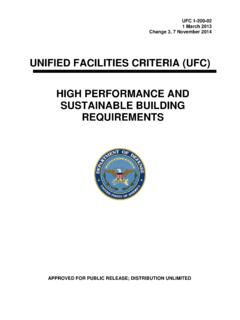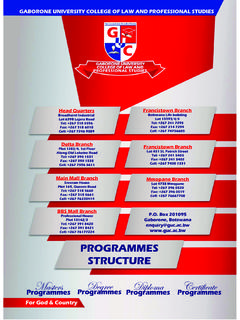Transcription of Department of Defense Guidebook for Acquiring …
1 Office of the Secretary of Defense Acquisition, Technology, and Logistics (Acquisition Initiatives) Department of Defense Guidebook for Acquiring Commercial Items PART B: PRICING COMMERCIAL ITEMS Table of Contents OVERVIEW .. 2 VISION FORWARD:THE COMPETITIVE MINDSET .. 2 CONTRACTOR ROLE IN SUPPORTING PRICE REASONABLE DETERMINATIONS .. 2 DEFINITIONS .. 3 MARKET RESEARCH .. 4 RECENT CHANGES TO MARKET RESEARCH REQUIREMENTS .. 4 INFORMATION SOURCES .. 4 1. First Source:Government Resources .. 4 2. Second Source:Sources other than offeror (public resources).
2 6 3. Third Source:Information from the Offeror .. 11 PROHIBITION ON OBTAINING CERTIFIED COST OR PRICING DATA .. 14 POINTS TO CONSIDER ABOUT MARKET RESEARCH .. 14 Document, Document, Document .. 14 Offeror Inability to Provide Requested Data .. 15 PRICING ANALYSIS .. 16 OVERVIEW .. 16 RECENT CHANGES TO PRICE ANALYSIS REQUIREMENTS .. 16 CONDUCTING PRICE ANALYSIS .. 17 Price Analysis Process .. 17 Price Analysis Techniques .. 18 Price Analysis Adjustments .. 36 PRIME AND SUBCONTRACT PRICE ANALYSIS .. 41 SERVICES PRICE ANALYSIS.
3 46 BEYOND PRICE ANALYSIS .. 50 PREPARING FOR AND CONDUCTING NEGOTIATIONS .. 52 OVERVIEW .. 54 DOCUMENTATION NEEDS .. 54 NEGOTIATION POSITION .. 54 SUMMARY HIGHLIGHTS .. 56 APPENDIX A:MARKET RESEARCH RESOURCES .. 57 APPENDIX B:DCMA CIG REQUEST TEMPLATE .. 62 2 Overview Commercial items are not subject to the Truthful Cost or Pricing Data Act, formerly known as TINA, because the commercial marketplace is presumed to be a competitive environment and should drive a fair and reasonable price. When determining a fair and reasonable price, market research should be conducted in order to compare the proposed price to comparable market pricing.
4 Determining a fair and reasonable price is usually a more straight-forward process when Acquiring commercially available off- the-shelf (COTS) items. One the other hand, determining a fair and reasonable price is challenging when the commercial market does not exist for a specific item or when market price data is not readily available. Ultimately, the effectiveness of price analysis will depend on what meaningful data the Government successfully obtains to conduct the pricing analysis. VISION FORWARD: THE COMPETITIVE MINDSET Department of Defense (DoD) Guidebook for Acquiring Commercial Items, Part A: Commercial Item Determination, highlights the importance of competition; maintaining a competitive mindset throughout the pricing evaluation is critical!
5 Government acquisition professionals should always explore the potential for competition as a critical consideration for not only prime contracts, but also for how they can encourage competition at the subcontract level. In general, when firms compete for business there is a competitive pressure to put forth their best price to ensure they win the award. Generally, competition in most commercial markets is the norm and not the exception. Theoretically, there should be limited circumstances in which or prime contractors are buying commercial items from a sole source without some benefit from the competitive commercial marketplace; however, the fact is DoD must acquire a significant amount of sole source items and services that meet the commercial item definition.
6 Frequently, DoD ends up in commercial sole source situations for reasons other than there only being one qualified firm that can provide the product or service. One common reason is the nonrecurring cost and time investment spent by the Government and commercial supplier to tailor their commercial item to meet a military purpose. While this is a hurdle it should not preclude contracting officers, prime contractors, and program managers from exploring options. We should, like industry, have a long-term view of affordability and savings rather than a short-term view based solely on immediate cost-avoidance, schedule, and funding limitations.
7 CONTRACTOR ROLE IN SUPPORTING PRICE REASONABLE DETERMINATIONS We often hear the acquisition process described as a team sport. The same can be said for commercial item determinations (CIDs) and the pricing of commercial items. In the event that information from the offeror is requested by the contracting officer, it is the role of the contractor to be responsive to those requests. If, for some reason, the offeror declines to submit the requested information to support CIDs or price reasonableness determinations, contracting officer contracting officers should request the offeror to assert its position in writing along with associated rationale for not providing the requested information.
8 At the end of the day, we should not be buying items or services at prices that we do not consider to be fair and reasonable. While it is our responsibility to perform adequate price analysis of commercial items, 3 that responsibility does not relieve the offeror of its obligation to support the reasonableness of its proposed prices if it chooses to supply goods and services to DoD. DEFINITIONS Pricing Data Pricing data are all facts, exclusive of separate cost elements or profit, which prudent buyers and sellers would reasonably expect to affect price negotiations Examples of pricing data include established catalog or market prices, or any form of data on sales to commercial and Governmental end users.
9 Cost Data Cost data are any facts, other than prices, that prudent buyers and sellers would reasonably expect to affect price negotiations Cost data should help you understand what the item did cost, will cost, or should cost. While the objective is to reach agreement on a fair and reasonable price without ever having to request cost data, did cost, will cost, and should cost data should be available from the offeror and may be available from sources other than the offeror. These concepts are not foreign to world class commercial firms who buy and sell complex commercial systems.
10 Use the wide spectrum of resources available to you, but be careful to follow the Federal Acquisition Regulation (FAR) order of preference and Defense Federal Acquisition Regulation Supplement (DFARS) hierarchy, discussed in the Market Research section of this Guide. Conducting a cost analysis and requesting cost information from the offeror should be the last resort when performing a fair and reasonable analysis for commercial goods and services. NOTE: Per Title 10, United States Code ( ) 2306a(b), submission of certified cost or pricing data shall not be required for any contract, subcontract, or modification of a contract or subcontract involving: Adequate price competition or prices set by law or regulations; and Acquisition of an item that meets the definition of a commercial item.










